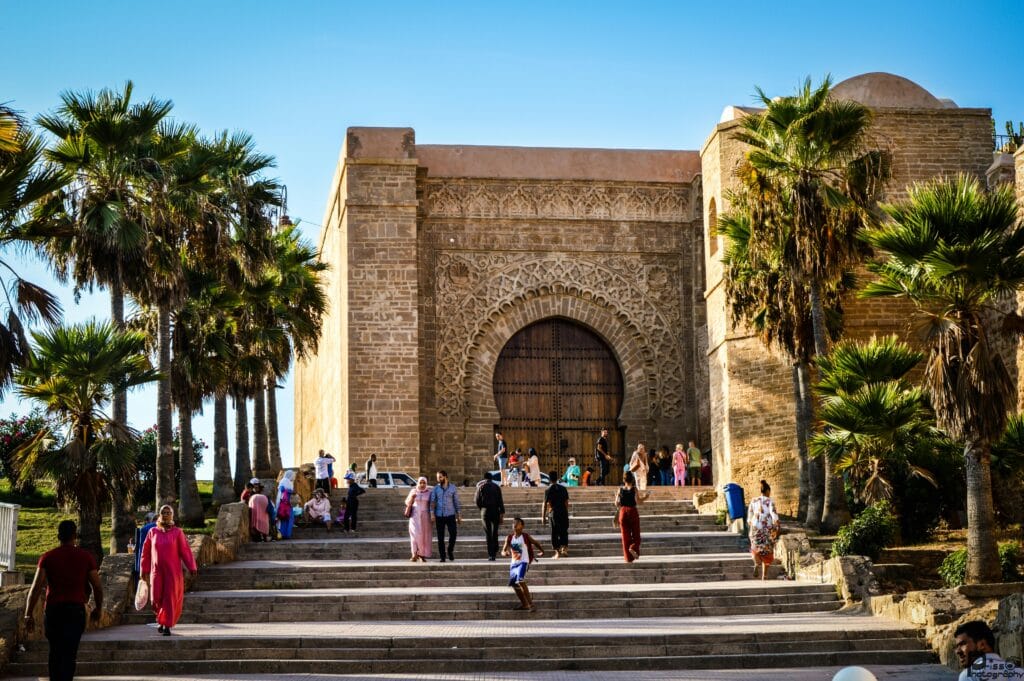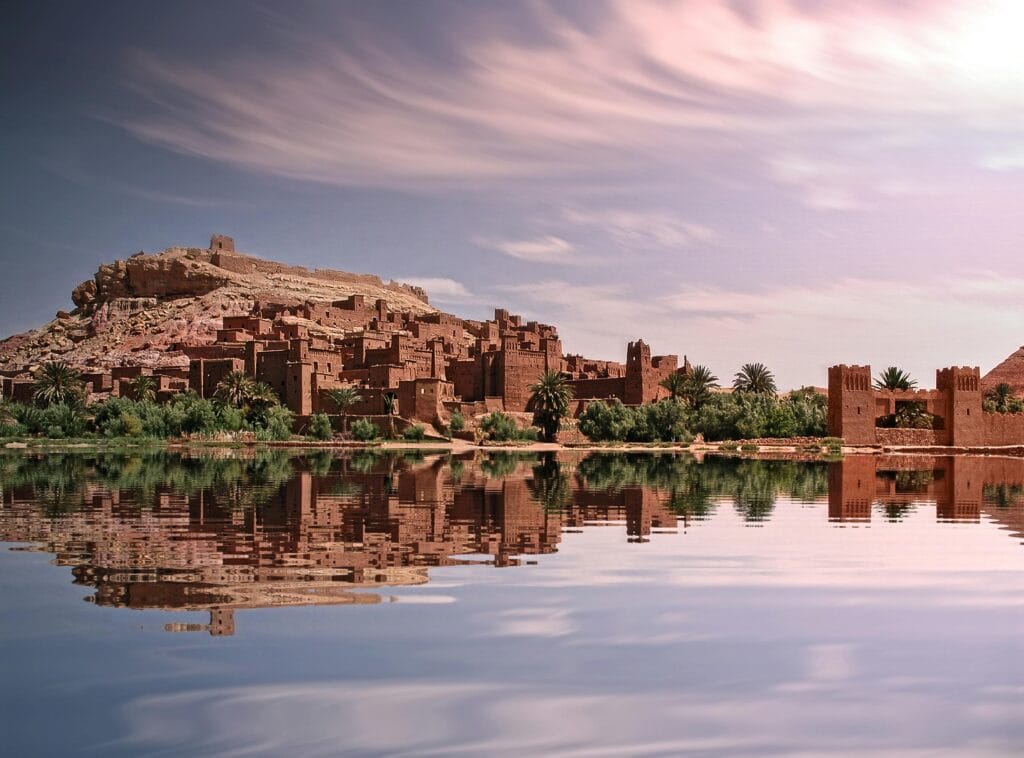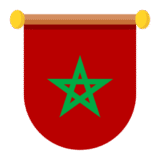Morocco is a country with a rich history, diverse culture, and varied landscapes. It promises an unforgettable experience for travelers. We’re excited to share the wonders of this beautiful country with you.
From bustling cities to serene beaches and majestic Atlas Mountains, Morocco offers a unique experience all year round. We’ll help you find the best time to visit morocco.
Whether you want to dive into the vibrant culture, relax on beautiful beaches, or trek through mountains, we’ve got you covered. Morocco is a year-round destination with a diverse climate and geography. We’re here to help you make the most of your trip.
Morocco’s Diverse Climate and Geography
Morocco is a land of contrasts, with coastal breezes and desert heat. Its geography is varied, featuring mountains, deserts, and coastlines.
From Coastal Breezes to Desert Extremes
The climate in Morocco changes a lot from one place to another. Coastal areas are mild and pleasant, thanks to the Atlantic Ocean. But, the deserts, like the Sahara, are very hot during the day and cold at night.
Cities like Essaouira and Agadir have a mild climate all year, perfect for tourists. But, the deserts are better visited in cooler months to escape the heat.
Four Distinct Climate Zones
Morocco has four main climate zones. There’s the Mediterranean in the north, the Atlantic coast, the Atlas Mountains, and the Sahara Desert. Each zone has its own charm and attractions.
| Climate Zone | Characteristics | Best Time to Visit |
|---|---|---|
| Mediterranean | Mild winters, hot summers | Spring and fall |
| Atlantic Coastal | Mild climate year-round | Anytime |
| Atlas Mountains | Cold winters, cool summers | Summer for hiking |
| Sahara Desert | Extreme heat, cold nights | Cooler months (October to February) |
Knowing about these climate zones is key for planning your Morocco trip. The weather greatly affects your experiences. Morocco offers something for everyone, whether you love cities, beaches, or mountains, all year round.
The Best Time to Visit Morocco: A Seasonal Overview
Timing is key for a great Moroccan adventure. The climate varies by region, so the best time to visit depends on where you go and what you want to do.
The spring (March to May) and fall (September to November) are the top seasons. The weather is mild and nice, perfect for city tours, outdoor fun, and cultural events.
Spring (March-May): The Golden Season
Spring in Morocco is lovely, with mild weather and blooming views. It’s great for Marrakech’s busy streets, historic city visits, and countryside explorations.
Fall (September-November): Perfect Balance
Fall in Morocco is excellent, with nice weather and fewer people around. It’s perfect for hiking, exploring the Atlas Mountains, and enjoying local harvests.
Avoiding Extreme Weather Periods
While spring and fall are best, avoid extreme weather times. Summer heat is tough, especially in the desert. Winter can be cold, limiting outdoor fun.
| Season | Weather | Activities |
|---|---|---|
| Spring (March-May) | Mild temperatures | City exploration, cultural events |
| Fall (September-November) | Comfortable temperatures | Hiking, outdoor activities, harvest experiences |
Choosing the right season makes your Moroccan trip unforgettable and fun.
Winter in Morocco: December to February
Morocco in winter is a mix of cold and warm. The Atlas Mountains get snow, while the desert stays mild. This makes Morocco a special place for those who want different winter experiences.
Coastal Areas and Northern Cities
Winter is perfect for visiting Morocco’s coast and northern cities like Casablanca and Rabat. The weather is cool, between 45°F and 65°F (7°C to 18°C). This makes it easier to see the sights without the crowds.
The coast has mild winters, thanks to the Atlantic breeze. It’s a great time to explore the cities, try local food, and enjoy the views.
Atlas Mountains and Snow Activities
The Atlas Mountains turn into a winter sports haven from December to February. With ski resorts like Oukaimeden and Michlifen, Morocco is a top spot for snow sports in Africa. You can ski, snowboard, and more in beautiful mountain settings.
The mountains also offer hiking and trekking with amazing views and fresh air. Morocco’s ski resorts offer a unique winter adventure.
Southern Desert Experiences
The southern desert of Morocco is warm in winter, with days from 60°F to 75°F (15°C to 24°C). It’s perfect for desert camping, camel rides, and seeing the Sahara Desert.
Visitors can enjoy the desert’s calm, stargaze, and learn about desert cultures. Winter is a great time to see the desert, avoiding the summer heat.
Spring Splendor: March to May
As spring comes to Morocco, the scenery changes into a colorful mix. The weather is mild, and the landscapes are vibrant. It’s the perfect time to see this beautiful country.
Blooming Landscapes and Moderate Temperatures
Spring brings new life to Morocco, with the Atlas Mountains and countryside full of flowers. The temperatures are just right, from 15°C to 25°C (59°F to 77°F). This makes it great for hiking, exploring, and enjoying the outdoors.
The rose festival in El Kelaa M’Gouna is a big event in spring. It draws visitors from everywhere. The festival celebrates the rose harvest with music, dance, and crafts. We love joining in the local traditions and festivities.
Spring Festivals and Cultural Events
Spring in Morocco is also filled with cultural festivals and events. Marrakech has music festivals and traditional celebrations. We dive into the local culture and see Morocco’s rich heritage.
- The Marrakech Popular Arts Festival showcases the country’s rich cultural heritage.
- The Essaouira Gnawa Music Festival is a unique experience, blending traditional Gnawa music with modern influences.
- The Fez Festival of World Sacred Music is another highlight, featuring performances by musicians from around the world.
These events give a peek into Morocco’s cultural heritage. They offer a special experience for visitors. Attending these festivals helps us understand the local culture and traditions.
Summer Heat: June to August
Summer in Morocco brings heat and life to the landscape. The desert is very hot, but the coast is cooler. This makes coastal areas great for escaping the heat.
Coastal Retreats and Beach Destinations
Morocco’s coast has lovely beach towns perfect for summer. Essaouira and Agadir are top choices. They offer water sports and beach relaxation. The coastal breeze is a nice break from the desert heat.
In Essaouira, you can enjoy a relaxed vibe, explore the medina, and try surfing. Agadir has a lively nightlife and many places to stay, from fancy resorts to affordable apartments.
Navigating Major Cities in Summer
Summer in cities like Marrakech and Fez needs planning. Stay hydrated, wear light clothes, and avoid hard activities when it’s hottest. Visit popular spots early morning or evening to miss the crowds and heat.
In Marrakech, walk the souks, see Jardin Majorelle, and relax in Menara Gardens. In Fez, explore the old medina, visit Al-Attarine Madrasa, and enjoy the culture.
Desert Travel Considerations
Traveling to desert places like Merzouga or Zagora requires care. Guided tours are helpful for dealing with the heat. They make your desert trip better.
When going to the desert, wear light, breathable clothes, a hat, and carry lots of water. Visit in the morning or evening when it’s cooler. A guided tour adds to your desert experience with history and culture insights.
Fall Magic: September to November
Fall in Morocco is a time of harvest and discovery. It offers a mix of tasty foods and outdoor fun. The country’s landscapes come alive as the summer heat fades, making it perfect for exploring.
Culinary Experiences and the Harvest Season
Harvest Season and Culinary Experiences
The fall in Morocco means it’s harvest time. This brings fresh produce to the local dishes. We enjoy meals made with ingredients picked right from the fields.
From Meknes’ olive groves to Berkane’s citrus orchards, the harvest is a big celebration. Visitors can dive into Morocco’s food culture by joining local events and trying fresh foods at markets and souks.
Fall is the best time to taste Morocco’s rich food heritage. The season offers a wide range of fruits and veggies, perfect for traditional dishes. For example, it’s a great time to try Argan oil, a key ingredient in Moroccan cooking.

Ideal Hiking and Outdoor Activities
Morocco is perfect for outdoor lovers in the fall. The weather is mild, and there are fewer people around. This makes it great for hiking in the Atlas Mountains and exploring valleys.
The todra and gorges of the Atlas Mountains are just the start. Morocco’s valleys and hills are also beautiful. The fall lets us enjoy these places at our own pace, taking in the culture and views.
“The mountains are calling, and I must go.” – John Muir
Fall is the best time for outdoor fun in Morocco. The weather is mild, perfect for hiking, camping, and exploring. As we enjoy nature, we remember to protect it for the future.
Regional Weather Guide for Morocco Travelers
Morocco’s geography leads to different weather patterns in each area. Knowing these variations is crucial for a great trip. It helps you plan and enjoy your time in Morocco.
Marrakech and Central Morocco
Marrakech and central Morocco have a dry climate with little rain. Summers are very hot, often over 38°C (100°F) in July and August. Winters are mild, perfect for visiting if you want fewer people and lower prices.
Spring and fall are the best times to see Marrakech and central Morocco. The weather is nice, and there are many cultural events.
Imperial Cities: Fez, Meknes, and Rabat
Fez, Meknes, and Rabat have a different climate than Marrakech. They get more rain, especially in winter. Spring is lovely here, with mild weather and green landscapes.
Summers are hot, but the historic sites and cultural spots are still attractive to visitors.
Blue City of Chefchaouen and the Rif Mountains
Chefchaouen, or the Blue City, and the Rif Mountains have a milder climate. They get a lot of rain in winter and spring. Spring is the best time to visit, with great hiking and natural beauty.
Coastal Cities: Casablanca, Essaouira, and Agadir
Casablanca, Essaouira, and Agadir have a mild climate due to the sea. Essaouira is famous for its breezes, attracting windsurfers and kitesurfers. Agadir is perfect for beach lovers, with warm summers and mild winters.
Casablanca, being a big city, has a more urban climate. But it still benefits from its coastal location.
Best Times for Specific Moroccan Experiences
Morocco offers something special in every season. Whether you love desert camping, surfing, hiking, or cultural tours, the best time to visit depends on your interests.

Desert Camping and Camel Treks
Spring (March to May) and fall (September to November) are perfect for desert adventures. The weather is mild, making it comfortable for exploring the vast sand dunes.
These seasons offer pleasant temperatures, from 64°F to 82°F (18°C to 28°C). It’s ideal for camping under the stars, camel treks, or simply enjoying the desert’s beauty.
Surfing and Water Sports
Fall and winter (September to February) are the best for surfing and water sports. The waves are at their highest, perfect for surfers of all levels.
Taghazout and Essaouira are top spots for surfers. The cooler months are also great for kitesurfing and paddleboarding.
Hiking and Mountain Exploration
Spring and fall are the best for hiking and exploring mountains. The weather is mild, and the landscapes are lush, making it perfect for the Atlas Mountains and Rif Mountains.
These seasons offer temperatures from 50°F to 68°F (10°C to 20°C). It’s ideal for hiking, trekking, and enjoying scenic views.
Cultural and Historical Tours
Morocco’s cultural and historical sites are open all year. But, the cooler winter months (December to February) are best for visiting cities like Marrakech, Fez, and Meknes.
Visiting during the shoulder season lets you avoid crowds. You can explore medinas, historic sites, and immerse yourself in Morocco’s rich culture.
Morocco’s Major Festivals and When to Experience Them
Morocco has many festivals all year round. These events show off the country’s diverse culture. They give visitors a peek into Morocco’s traditions and customs.
Religious Celebrations and Holidays
Morocco is mostly Muslim, and Islamic holidays are big deals. Eid al-Fitr is a major celebration, ending Ramadan, the fasting month. The dates change with the Islamic calendar, so check ahead of time.
Mawlid al-Nabi, the Prophet Muhammad’s birthday, is also a big event. It’s filled with festivities and religious gatherings all over the country.
Music and Arts Festivals
Morocco’s arts scene is lively, with many festivals for music, film, and more. The Marrakech International Film Festival is a big deal, drawing stars and filmmakers. It’s a chance to see top Moroccan and international films.
The Essaouira Gnawa Music Festival celebrates Gnawa music and culture. It features local and international musicians, offering a unique musical experience.
Regional and Cultural Celebrations
Morocco’s regions have their own cultural events, showing the country’s rich heritage. The Rose Festival in El Kelaa M’Gouna is famous, celebrating the rose harvest with parades and music.
The Imilchil Wedding Festival in the Atlas Mountains is another highlight. It’s a traditional Berber wedding that draws visitors worldwide.
These festivals are more than just fun events. They offer a glimpse into Morocco’s cultural heritage. By attending these festivals, visitors can learn more about Morocco’s traditions and way of life.
Budget Considerations: High Season vs. Low Season
When planning your Moroccan trip, think about the budget impact of peak and low seasons. Knowing how your travel costs will change based on when you go is key.
Peak Tourist Periods and Price Fluctuations
Summer and major festivals are peak times, making things pricier. More people want to visit, leading to higher prices for hotels and tours.
For example, hotel prices vary a lot between peak and off-peak seasons:
| City | Peak Season Price | Off-Peak Season Price |
|---|---|---|
| Marrakech | $150/night | $80/night |
| Casablanca | $120/night | $60/night |
| Fez | $100/night | $50/night |
Finding Deals in Shoulder Seasons
Spring (March to May) and fall (September to November) are shoulder seasons. They offer nice weather and fewer people, with prices that are easier on your wallet.
Spring in Marrakech means beautiful flowers and cool weather without the high prices. Fall in coastal cities like Essaouira is also great, with fewer tourists and lower costs.
Thinking about your travel timing can help you save money in Morocco. Whether you go during peak or shoulder seasons, knowing the price changes helps you budget better.
Conclusion: Planning Your Perfect Moroccan Adventure
We’ve wrapped up our guide on the best time to visit Morocco. Now, you know how to plan your trip based on what you like. Morocco’s climate, culture, and landscapes change with the seasons, making it a great place to visit any time.
Looking for culture, outdoor fun, or a calm break? Morocco has it all. Think about the weather, local events, and what you want to see. We’re here to help you explore Morocco‘s beauty, from Marrakech’s lively streets to the peaceful Atlas Mountains.
When planning your Moroccan trip, pick the best time for you. The perfect season varies, but our guide helps you decide. Spring, fall, or any other time, Morocco promises a trip you’ll always remember.

